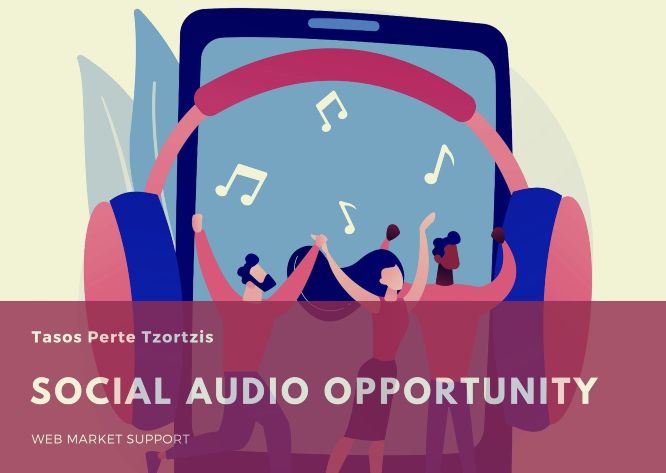When we say “Social Audio” we refer to social media platforms and apps where we can use audio as a means for communication. We all use text, videos, emojis, GIFs, graphics, images, and other visuals to get in touch with people and brands on various social networks.
But now audio seems like an emerging trend.
Podcast has seen tremendous growth during the last 10 years.
According to Forbes…
With 60% of podcast listening done at home, adoption was especially notable during the pandemic. According to the latest Infinite Dial survey from Edison One and Triton Digital, in 2020, 37% of Americans (age 12+) listen to at least one podcast each month, up from 32% in 2019. The continued growth of podcast listening is expected. In 2020, an estimated 100 million people listened to a podcast each month and it’s expected to reach 125 million in 2022.
And we believe that podcast has laid the ground for social audio.
Is social audio a huge opportunity or a waste of time, just another shiny object? Let’s dive in!
The “Social Audio” Opportunity
Illustration by vectorjuice/Freepik
Podcast Vs. Social Audio
The majority of podcasts are pre-recorded audio sessions and you can download them for easy access at a later time.
There are also live podcast shows and events, for example, interviews and other group shows where you get to listen to the host and guests talking about a topic.
On the other hand, social audio gives listeners the opportunity to participate in the discussion in real-time. The audience is active, they do not just listen to the host and guests. They are guests as well.
Podcast is a passive medium from a listener’s perspective, and social audio is an interactive medium.
%
Podcast listening done at home
Advantages
It’s an interactive medium, where the host or hosts can discuss in real-time with their audience and guests.
It’s a very similar experience to live video conferencing on platforms like Skype or Zoom. But in this case, you don’t have to worry about the way you look, having the perfect background or decoration, and other things.
It happens in real-time, it’s live, fresh, at the moment.
It’s fast, way faster than texting, and faster than video streaming.
It requires less internet connection bandwidth than video.
It’s effective as you get to understand someone by their voice tone.
It’s a great tool for brands, agencies, and other professionals to provide customer service support, answer questions, and interact with followers, fans, and customers in real-time. It’s way more effective compared to social chats that take place in private rooms or publicly where you can only use text.
%
Americans (age 12+) that listen to at least one podcast each month in 2020
%
Americans (age 12+) that listen to at least one podcast each month in 2019
Drawbacks
From a technical standpoint, the social networks that offer audio conversations have to moderate and filter the discussions.
According to Wired, Clubhouse has already faced issues with harassment, and Twitter struggles with problems like abuse and disinformation on its main service. Will Partin, a researcher at Data and Society’s Disinformation Action Lab, says that
“one of the big challenges of open social networks like Twitter is that what’s OK in one community is seen as wrong in another one”
and that Discord, which gives its closed communities the tools to police themselves, has had more success with moderation at scale.
People also worry about their safety and what happens with their conversations. Are they being recorded or not?
The social platforms need to give the hosts the ability to record only themselves and not people that interact with them and don’t want to be recorded.
People that listened to a podcast each month in 2020
People that will listen to a podcast each month in 2022
The Rise Of Social Audio Platforms
In a previous article, we discussed various social audio platforms. ClubHouse, LockerRoom, Discord, FireSide, and more.
Related:
Now I want to focus on ClubHouse.
According to TechCrunch and App Annie…
Social audio app Clubhouse has now topped 8 million global downloads, despite still being in a prelaunch, invite-only mode, according to new data released today by mobile data and analytics firm App Annie. Per its estimates, Clubhouse grew from over 3.5 million global downloads as of February 1, 2021, to reach 8.1 million by February 16, 2021. This sharp growth is attributed to several high-profile guest appearances, including those from Tesla and SpaceX founder Elon Musk and Facebook CEO Mark Zuckerberg, for example.
ClubHouse launched amidst the covid-19 pandemic. Social distancing and isolation played a big role here and the social audio app saw an increase in growth even as a closed beta invitation-only app.
The app was designed to give its users the freedom and the convenience to use it on the go, while driving, literally anywhere.
Users do not have to scroll down a page on the screen and can enter a chat room immediately and switch between rooms. They can listen to others or participate in the discussion.
ClubHouse is only available for iPhone users but right now they are building an Android version (that’s for me).
*Clubhouse is now available on Android.
Who Can Use Social Audio
Companies, agencies, and business owners that want to provide customer support, get feedback on products and services, perform audio surveys, build brand awareness, and so much more.
Marketers that want to connect with followers, partners, and brands they cooperate with, to promote products and services, announce deals, and so on.
Podcasters that want to add a new dimension to their shows.
People using video platforms like YouTube or Vimeo that want to test a new way of connecting with their audience online.
Coaches, consultants, and other professional service providers as an alternative to video conferencing.
Consumers looking to connect with their favorite brands on the net, get the latest updates about products, and discuss issues and problems they deal with.
People that want to entertain themselves, discover news, or get specialized knowledge in a topic.
Those that want to discuss specific topics (games, arts, tech, business, etc) with a group of like-minded individuals.
Anyone with a message that wants to share it publicly and discuss it with others.
Anyone that wants to broadcast a conversation about anything.
And the catalog goes on. Anything we do on social media can be done through audio.
Clubhouse global downloads as of February 1, 2021
Clubhouse global downloads as of February 16, 2021
Monetization
The networks providing social audio capabilities can easily monetize the service in many ways. They could sell premium features, accept sponsorships, and even add paid advertising platforms (pay-per-click aka ppc, cost-per-impression or cpi models, push notifications and pop-up ads, and so much more).
Related:
Brands and business owners, solo entrepreneurs, practitioners, coaches, consultants, other professionals could also monetize their appearances and visibility by redirecting attendees to their web properties and landing pages with the goal of selling their products and services online, through sponsorships, by announcing hot deals, flash sales, discount coupon codes, answering questions about products and services that lead to purchases, joint ventures with other brands by co-hosting shows and discussions, through sponsorships, and more.
Additionally, social audio apps like Clubhouse, let members monetize their presence by accepting tips, a form of donations. This is happening in real-time inside the rooms.
Listeners can tip their favorite speakers at a moment’s notice.
Is Social Audio Going To Fade?
We can’t predict the future but the signs are all positive. I think it’s a medium that people will embrace for many reasons.
Beyond the numerous advantages for all the parties involved, networks, brands, hosts, guests, consumers, fans, and random people, giant networks like Twitter and Facebook are working toward this direction.
Right now, we all are in need of communication in real-time as we are isolated due to the covid restrictions and audio-only chats are a great alternative to video call sessions. But even when the pandemic is over or under control, people will continue using the apps as they are fun, entertaining, and provide a good user experience.
Additionally, the tremendous growth of ClubHouse will attract thousands of competitors that will develop their own versions to compete and even beat the newborn king.
And one final thing;
I predict that more and more brands are going to adapt audio-only apps (live audio chats) to provide customer service and support on their websites (modeling social networks) as texting messages and waiting for an answer can take hours or days in some cases. It’s faster than making a phone call and doesn’t add any cost to the final consumer.
Let’s see what happens.
That’s it, another article has finished, here on Web Market Support. Are you a fan of social audio? Are you using an app? I’m waiting for your comments and thoughts. Till next time.

Tasos Perte Tzortzis
Business Organisation & Administration, Marketing Consultant, Creator of the "7 Ideals" Methodology
Although doing traditional business offline since 1992, I fell in love with online marketing in late 2014 and have helped hundreds of brands sell more of their products and services. Founder of WebMarketSupport, Muvimag, Summer Dream.
Reading, arts, science, chess, coffee, tea, swimming, Audi, and family comes first.



















0 Comments